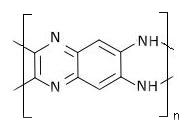| A ladder polymer is a double-strand macromolecule consisting of an uninterrupted linear sequence of rings, with adjacent rings having two or more atoms in common [1]. The ladder repeat unit has two pairs of open bonds. Each pair is formally linking two contiguous units together and thereby makes a strand. In the following example the upper open imino bond is linked with the upper open aromatic bond of the next unit, defining the upper strand, and the lower open imino bond is connected with the lower open aromatic bond, defining the lower strand: | |||
|
|||
| A dictionary entry with key i is required in each +n annotation to assure correct connectivity. The entry with key ilu, which is required in one of the two +n annotations, identifies all nodes belonging to the ladder unit—in this case all nodes of the notation. | |||
Tweet
_
__
__
 __
__
__ ___ 
|
References
| [1] | J. Vohlídal et al.: Glossary of Class Names of Polymers Based on Chemical Structure and Molecular Architecture. Pure Appl. Chem. 2009, 81 (6) 1131-1186 (section 4.11). pdf: www.iupac.org/publications/pac/pdf/2009/pdf/8106x1131.pdf. |
| [2] | A. Drefahl: CurlySMILES: a chemical language to customize and annotate encodings of molecular and nanodevice structures. J. Cheminf. 2011, 3:1; doi: 10.1186/1758-2946-3-1. |
| Encoding of polymers |
|
Homopolymers |

Custom Search
|
